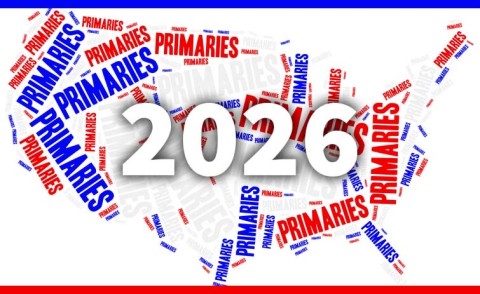
Everything You Need to Know to Participate in the 2026 Midterm Primaries
Learn about the 5 types of primaries and which type is implemented in your state
Primary season is upon us, and given the election’s complexity, voters should review the rules before casting ballots. Check your state’s primary election schedule and register to vote today to make sure you don’t miss an opportunity to make your voice heard this year!
What are the different ways that primaries are conducted?
There are five types of primaries conducted in the United States: open primaries, primaries open to unaffiliated voters, partially open primaries, closed primaries, and semi-closed primaries. Here we provide details on the several types of primaries:
1. Open primaries
In states with open primaries, voters may select either party’s nominee for office regardless of one’s party registration. Voting in a primary in “open” states does not register one with the party whose candidate the voter selects. Critics say this type of primary dilutes the party’s power to control the process and ensure that candidates reflect party politics. Proponents argue it prevents polarization.
If you live in one of the following states, you may vote in an open primary: Alabama, Arkansas, Georgia, Hawaii, Michigan, Minnesota, Mississippi, Missouri, Montana, North Dakota, South Carolina, Texas, Vermont, Virginia, and Wisconsin.
2. Primaries open to unaffiliated voters
In these states, only voters who are unaffiliated – and not registered with either party – may vote for any party’s candidate. Unlike truly “open” primaries, crossovers from one party to another aren’t permitted here.
If you live in one of the following nine states, you may vote as an unaffiliated voter: Arizona, Colorado, Maine, Massachusetts, New Hampshire, New Mexico, North Carolina and Rhode Island.
3. Partially Open Primaries
In these primaries, voters may choose any party’s candidate but must do so publicly so the parties can review this information. This allows the parties to solicit voters or re-register them under the party whose candidate they selected.
If you live in one of the following states, you may be eligible to vote in partially open primaries: Illinois, Indiana, Iowa, and Ohio.
4. Closed Primaries
Only voters registered with a party may vote for that party’s candidate. This means no unaffiliated or independent voters and no voter registered for one party can “crossover” and vote another party’s ticket. Critics view this as unfair and un-democratic (with a little-d), while proponents argue closed primaries ensure only party members can define the party’s agenda.
If you live in one of the following states, you can only vote in a closed primary if you’re registered with the party whose ballot you’re voting: Delaware, Florida, Kentucky, Nevada, New Jersey, New York, Pennsylvania, Tennessee and Wyoming.
5. Semi-closed Primaries
In these states, parties are permitted (but not required) to allow unaffiliated or independent voters to select candidates on their party ballot. They are not required, though, to permit crossovers from another party to vote.
If you live in one of the following states, and are not registered with a party, you may be permitted to vote in a semi-closed primary: Connecticut, Idaho, Kansas, Maryland, Oklahoma, Oregon, South Dakota, Utah and West Virginia.
Didn't see your state on the lists above?
Note that Alaska, California, Louisiana, Nebraska, and Washington run primaries in a less partisan manner. Check your local election official’s office for more details if you live in one of these states.
Whatever type of primary the state runs, a voter often has the option to vote in person on Election Day, vote by mail or absentee ballot, or even vote early in person. All states but one – North Dakota – require an eligible citizen to first register to vote, often 30 days before an election. By this deadline, too, one can usually change party registration, or select it for the first time. That way, if you’re unimpressed with your current party’s candidates, and you live in a state that restricts who can vote in a party’s primary, you can re-register by the deadline to vote.
How did primaries even begin? Here's some background:
The United States is the only major democracy using primary elections to narrow down nominees for office from a selection of candidates. And we haven’t always done it this way. In fact, relying on primary elections as the only way to pick a party’s nominees for president, Congress (both representatives and senators), and various other state and county offices has only been in effect for the past 50 years.
In 1972, after Hubert Humphrey bypassed the primary process when seeking (and winning ) the presidential nomination from the Democratic Party, the Democratic National Committee (DNC) instituted reforms to the nomination process. These reforms relied heavily on establishing a primary election process to help pick the nominees. The Republican National Committee (RNC) soon followed suit. Since then, all states have implemented primary elections at both presidential and midterm elections. A small handful of states – such as Iowa – hold public caucuses instead.
While the two parties greatly influence the primary process, states themselves run the elections (while the parties run their caucuses). This means all states must abide by federal laws governing elections, as well as abiding by their own state laws. It also means states set the rules for these elections, which explains why primary processes and primary election dates differ across states.
Additional resources to help you vote in the next election:
- Check your voter registration.
- Get your primary absentee ballot, or vote by mail.
- Check your primary election dates
- Find your state voting requirements, including ID.
What Are Congressional Midterm Primaries - Check Your Primary Election Schedule